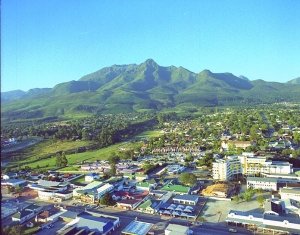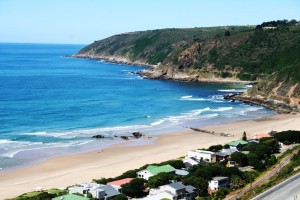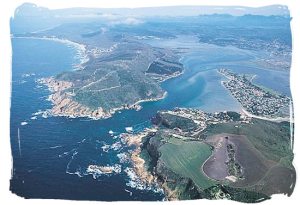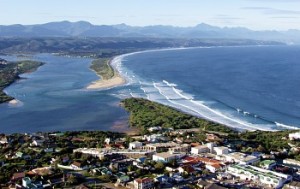©2011 Edward C. Lunnon
Tuesday 13 December 2011: 5 years 3 months on … Deuce
The City of George lies at the foothills of the Outeniqua Mountains. When I was involved in staff training there, each morning I would always take the employees outside of the training room and get them to look up at the mountains and savour the beauty. They thought I was mad, but such is the beauty of George and its surrounds.
It is possibly the first town in South Africa (outside of my home towns) that I have really got to know well. I first started visiting there when I was a student at Stellenbosch. The home of Dr Hendrik du Toit and his wife Anna at 21 Caledon Street was a favourite visiting place. One December night we even ended up pitching a tent on their front lawn after we had hurriedly left the “rage” at Plettenberg Bay. (We could no longer afford the in-season tariff at the Plett caravan park!)
Their daughter Gretel was in my education classes, their son Ludwig lived in Helshoogte with me and in later years, Gretel married Willem Wüst who was my predecessor as Primarius of Helshoogte.
I continued visiting there during 1982 and 1983 when I was at Infantry School in Oudtshoorn, just over the Outeniqua Pass. Official weekend passes and some AWOL passes would see my red Toyota Corolla head over that pass and to George and the delightful Vic(toria) Bay, a paradise for those who surf, fish, swim or tan!
In later years, during my working career, I spent many a night away from home, and my hotel homes away from home in the Southern Cape varied between the King George Hotel, Far Hills, Wilderness Karos and the Wilderness Holiday Inn.
The N2 from George runs eastwards past the Far Hills Hotel and the turn-off to Vic Bay, into the pristine Kaaimans River Valley, over the unique bridges and overhanging roadways (incidentally designed by Willem’s father), past that famous arced railway bridge that traverses the Kaaimans mouth, past Leentjiesklip and into the Wilderness.
I was privileged to spend a New Year’s Eve on the beach at Leentjiesklip (’79 or ’80?). There is nothing more spectacular than watching the sun rise over the Indian Ocean at the Wilderness.
It was here that ex-MP, prime minister and State President PW (finger-wagging) Botha lived and died at his home Die Anker (“the anchor”). It overlooks the Lakes that stretch from Wilderness all the way to Sedgefield and beyond to Lake Pleasant and its hotel (now a health clinic specialising in skin ailments).
Then, just before one drives over the hill and into Knysna, is the turn-off to Buffelsbaai, a very special little holiday resort, where, when Sean was just a crawling baby, we twice rented a holiday home and spent some very special holidays.
On the coastline, the white beach sweeps away eastwards to Brenton-on-Sea. Inland, there is the magnificent Knysna lagoon with Brenton-on-Lake and Belvedere on its south side, Leisure Island and Thesen’s Island in the lagoon, and Knysna itself on the northern and eastern banks of the lagoon. No words can do any justice to the picture created by the panoramic view that culminates in the Knynsa Heads, that place where the lagoon empties into the Indian Ocean through those magnificent rock columns on the west and east sides of the mouth.
The Knysna Forests stretch from George in the west, around the lagoon and onto Storms River in the east. The forests are the home to the famous Knysna Elephants, many stories and books (just two weeks ago we saw the musical Fiela’s Child which is set in these forests) and to the annual Knysna Marathon and half-marathon. I ran my first half-marathon in the Knysna forests in 2000 – and another three after that. Next year, we plan to return to Knysna in July to walk that route of 21 km.
As one leaves the Knysna lagoon area and proceeds eastwards to Plettenberg Bay, one passes the Knysna Elephant Park, numerous tourist accommodation establishments, the Big Tree (in the Garden of Eden) and, just off the main road, the Noetzie Castles, the somewhat eerie stone castles built on the beach at Noetzie and looking southwards out over the Indian Ocean. (Also here, is the start of the gravel road that runs northwards through the forest, over the Prince Alfred’s Pass and on into the Langkloof and Uniondale.)
Then there’s Plettenberg Bay, stretching from the imposing Robberg Peninsula in the west to the cliffs and mountains in the east, past Keurbooms River and Keurboomsstrand.
Plett has always been a special place for me. Just as our children today spend time after their school-leaving exams here at what has become known as “The PLett Rage”, we came here annually in November from Stellenbosch as soon as we had written our year-end university examinations. What goes on tour, I guess, stays on tour!
As a bachelor and later as a family, we have spent many delightful holidays in and around Plett, and visiting the Uptons, the Scholtz’s, the Bryants, the Walshes, the Browns and others. For a while, we were also property owners here when we bought a plot of land at Sanderlings Estate next to the Keurbooms River. We sold it, however, just after we had plans drawn up for a house there, but then decided to buy in St Francis Bay instead.
And so the road continues eastwards to Port Elizabeth, some two hours (200km) away. The Garden Route passes Natures Valley, over the Blaauwkrantz Pass and Bridge (now the site of the Bungee Jumping business), through the Tsitsikamma Forest and Coastal Nature Reserve and comes to an end at the Storms River Bridge – an obligatory stop and which I have written about previously.
From there, the N2 continues in a very different type of landscape past Humansdorp, St Francis Bay, Jefferys Bay and into Port Elizabeth and Nelson Mandela Bay.






